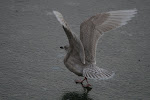Juvenile male Robin
We woke up at 3am this morning to a brisk wind that was too strong to do any mist-netting so we waited until mid-morning and went to Öby Kulle, erecting 4 nets. We only caught 7 new birds made up of 5 Willow Warbler, a juvenile Spotted Flycatcher and a juvenile male Robin.
This was a puzzling Robin for me, because the post-juvenile moult was only just 2/3 of the way though, but the breast was fully orange, there was a moult limit in the greater coverts and the outer two primaries appeared to be of a different generation in the field.
Analysis of the photos reveals that there is only 1 'adult' greater covert, the other 2 primaries appear to just be slightly more worn than old and the retained juvenile tertials confirm the age as Juvenile. An interesting bird
Robin's in Sweden are generally much greyer and paler than the British birds I am used to, so are a real treat to see, however this bird was almost a mix of the two, presumably based on the freshness of the new feathers and the warm brown in any retained juvenile feathers. Stephen Menzie describes it very well here
The weather looks pretty good tomorrow so should hopefully catch over 100 birds if we're lucky.




2 comments:
Hi Zac,
Thanks for the link :)
I'd say this is actually a pretty typical 1cy Robin (best not to use the term 'juvenile' when the bird is no longer in juvenile plumage). Intrigued by your "2/3 of the way through [p-j moult]" comment though; was the bird still actively moulting? Seven retained juvenile greater coverts, as shown by your bird, is pretty typical for a Robin. Passerines have 10 greater coverts, so that means this bird has moulted the three innermost (partly hidden under the scapulars on the photos). The body feathers appear to have finished (or have very nearly finished) moulting from juv to 'first-winter' and the moulted greater coverts are fully grown — I would suggest this bird has or is extremely close to having finished its p-j moult, thus more like 95-100% through p-j moult rather than 66% through.
Well when I saw 2/3, it's because we are currently using a PJM scale for the body feathers currently, and this was PJM 4 out of 6, so the lower breast sides are being moulted/growing and the top half are complete (it's more specific than that, but I won't go into details because our scale is being used for a specific study), so I meant 2/3 of that scale...I agree that this may cause confusion to a moultaholic such as yourself ;)
Zac
Post a Comment